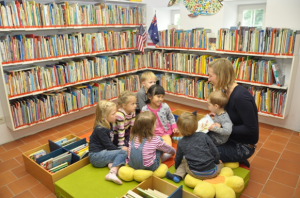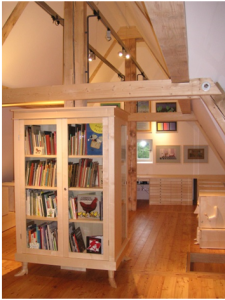| The International Youth Library in Munich: A book castle with children’s literature from all over the world
Petra Rauschert |
Download PDF |
‘Give us books, give us wings’ (Lepman, in Betten, 1992)
When Jella Lepman founded the International Youth Library in 1949, she had a vision: by using international children’s literature she wanted to educate children, help them become open-minded world citizens and promote international understanding and peace. With the International Youth Library, she not only launched an enormous project to foster literacy and cultural exchange but paved the way for young Munich readers to immerse themselves in the world of books and be transported to the heady heights of stories from all around the globe.
Blutenburg Castle, © IJB
The International Youth Library is the largest library for international children’s and youth literature in the world. It houses a collection of more than 620,000 books in 130 languages published over the past 400 years, including 70,000 historical books, 30,000 volumes of secondary literature, 130 subscriptions to current journals and 4,400 posters. [End of Page 85]
Book donations are received from international publishing houses and private sponsors regularly, so annually the library expands by some 10,000 new titles. To help booklovers find particularly interesting and innovative pieces, the library has an online catalogue (www.ijb.de) for its complete holdings, and also publishes the annual White Ravens catalogue, which highlights a selection of 200 new publications from 50 countries written in more than 30 languages. During the biennial six-day White Ravens Festival, authors from different countries come to read their work in their native language, supported by translators and moderators. The next festival will take place from 16 to 21 July 2016.
The library is housed in the medieval Blutenburg castle, which enables visitors to feel like they are being transported into a fairy tale world. This fantastic venue has much to offer its visitors, both young and old. Children might first want to explore the children’s lending library that enables them to browse through 25,000 books and other media in about 20 languages. Additionally, they are invited to participate in reading programmes as well as language and painting courses.
Lending Library
Binette Schroeder Cabinet, © IJB
Just across the courtyard, the research library contains a reference collection of primary and secondary literature, historical children’s books and professional journals. To support research in the field of international children’s and youth literature on a long-term basis, and to promote academic exchange, the library has a fellowship programme enabling up to twelve international scholars to engage in research at the library each year. This [End of Page 86] programme, funded by the Foreign Ministry of the Federal Republic of Germany for the past 50 years, allows scholars to stay from six weeks to four months and to work on research projects related to children’s literature.
The medieval castle also hosts various exhibitions related to international children’s and youth literature as well as illustrations, which may focus on a thematic or literary aspect of children’s literature, such as ‘Night-time’, ‘Creation myths from around the world’, ‘Unusual alphabet books’, ‘Robinsonades’ or ‘Sports in young adult literature’. Besides these temporary exhibitions, permanent exhibitions on single authors and illustrators can be visited as well. They provide interesting insights into the life and works of German authors such as Michael Ende, Erich Kaestner, James Kruess and the illustrator Binette Schroeder. The library also offers numerous workshops for school classes to work with the exhibitions in a creative way.
The library has developed and changed since Jella Lepman’s days. But the educative spirit and the mission to preserve literary treasures as well as to spread these ideas across the world have lost none of their relevance. Bringing together children’s and youth literature from around the world was seen as an opportunity to find new hope and regain values after years of war and to foster an understanding of other nations. Today, Dr. Christiane Raabe, current director of the International Youth Library, speaks in her essay on the library of a ‘Book Castle with Many Windows onto the World’ (Raabe, 2015). And that is exactly what you will find when you visit this library: a book castle that not only leads you into fairy tale worlds but also raises awareness of cultural diversity as it is manifested in the world’s literature to foster cross-cultural dialogue.
References
Raabe, C. (2015). A Book Castle with Many Windows onto the World. Anniversary Edition of the Japanese Board on Books for Young People (JBBY).
Petra Rauschert (PhD) works as a lecturer of TEFL at the University of Munich. Her research focuses on Intercultural Service Learning and Citizenship Education. [End of Page 87]




